The oceans hold 97% of all earth’s water, but don’t bother moving your homestead to the coast if you’re looking for a secure supply for you and your family.
Desalinating sea water requires tons of energy, (and money, on a large scale), so even in regionally water-stressed areas it’s impractical. Of what’s left, 2.5% of earth’s water is unavailable, meaning too deep, too frozen, or too dirty. That leaves only 0.5% of usable fresh water on this planet for people and land dwelling organisms.
It should be no wonder then that our utility bills are so high. From such a limited resource, the average person still uses 3,000 gallons of it a month without hardly a thought. This is literally flushing money down the toilet. What’s even crazier is when there is an emergency and the whole town stocks up on bottled water, like that’s going to do much of anything. There is only one way to bring utility costs down AND have enough water on hand in an emergency, and that is by being water independent, not dependant on public works.
When you are responsible for your own supply of water, you’re also more conserving with it, too. The good news is that there are plenty of untapped sources of freshwater on your property, and with the right system of conservation and ingenuity can help you become more independent and prepared for hard times.
Each of these off-grid water systems are best when combined. Depending on one alone opens you up to more risk of not having enough water on hand, but using two, three, or more can ensure there is plenty for you and your homestead.
The Most Simple One
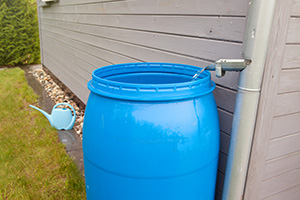 Some good things do actually fall from the sky. Rain barrels can be set up anywhere beneath the heavens, and provide a huge supply of clean water with one torrential downpour.
Some good things do actually fall from the sky. Rain barrels can be set up anywhere beneath the heavens, and provide a huge supply of clean water with one torrential downpour.
An easy way to make one in five minutes is with a 50 gallon plastic trash can with lid, some landscape fabric, a ¾” garden spigot, a double threaded bulkhead fitting with an internal thread size of ¾”, some Gorilla Tape and teflon tape, a pen to trace a hole and a razor blade to cut it out.
The spigot will go near the bottom of the trash can, so trace a hole around the bulkhead there, and cut it out. Insert the bulkhead and screw the nut on back. Wrap teflon tape around the threading on the spigot a few times next, then screw the spigot into the bulkhead until it’s facing down and is tight. Cut a wide hole out of the trash can’s lid.
The landscape fabric will be pulled tight over the top of the can and secured with Gorilla Tape, and the lid with a hole placed back on top of this. That way, debris and mosquitoes won’t contaminate the rainwater, which should filter through the fabric and into the barrel.
The Second System
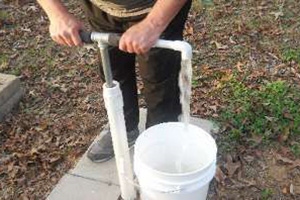 Hand pumps require drilling down into an aquifer and using manual labor to pump it to the surface.
Hand pumps require drilling down into an aquifer and using manual labor to pump it to the surface.
Electric pumps can be used, but if it went out during an emergency you’d wish you had the more strenuous option.
There are established companies in the U.S. that could build and drill for you, but expect to pay a couple thousand dollars, at least.
Related: 10 Survival DIY Projects You Can Start on Your Property Right Now
Another Idea For Your Property
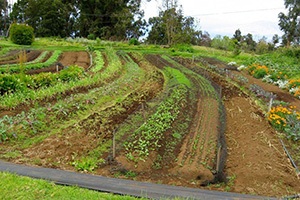 A great way to prevent rainwater escaping downhill as runoff and soak into the soil of a garden, instead, is by creating a permaculture swale.
A great way to prevent rainwater escaping downhill as runoff and soak into the soil of a garden, instead, is by creating a permaculture swale.
This will take planning and observation of water flow and drainage on the ground you build upon, but can make a planting area more productive and less maintenance.
You need to watch which way the water runs when it rains, then dig a trench along those contour lines evenly to slow and retain the water, typically 6 inches to 1.5 feet deep, and 18 inches to two feet wide. The dirt removed will be built up as a berm along the downhill side of the trench.
In desert areas the trench is then planted, and generally the berm is in non desert climates. The water pooled and slowed from draining off will drain instead into the immediate soil, making it healthier as organic matter grows over time.
A Water System For Huge Supplies
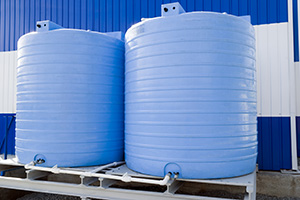 A cistern will give you peace of mind knowing you have a huge supply of water on standby.
A cistern will give you peace of mind knowing you have a huge supply of water on standby.
These can range in materials from made out of stone or metal, and can hold 10,000 gallons or more or less depending on what you and your property can handle.
Something to be aware of is their potential weight when full, though, and where it’s built. It will sink if the ground isn’t sturdy enough. Also, if it freezes where you live, burying it in the ground might prevent it, too, from doing so.
An Underground System
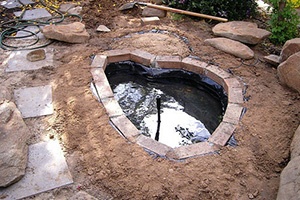 A natural or man-made pond can hold lots of water, and organisms to prevent stagnation or possibly be eaten, too.
A natural or man-made pond can hold lots of water, and organisms to prevent stagnation or possibly be eaten, too.
The water will have to be cleaned thoroughly before used for drinking or cooking, of course, but it’s always a viable option if need be.
Stocking it with fish provides a bonus food source. A pond dug 8-12 feet will allow them to survive if it freezes. A lot of consideration should be made before you dig, but lining the pond with a tarp and some geotextile material will reduce seepage after it’s done.
Another Idea For Your Backyard
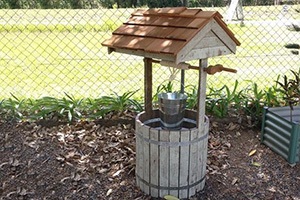 A well on your property will be a relatively stable and clean source of water. They are typically anywhere from 20 to 300 feet deep, which means being protected from freezing in the winter.
A well on your property will be a relatively stable and clean source of water. They are typically anywhere from 20 to 300 feet deep, which means being protected from freezing in the winter.
If your property doesn’t already have a well, however, it will cost at least a couple thousand dollars to dig and implement one. But the money saved will outweigh the cost.
Aqueducts
I’m sure you’ve seen the Romans harness the power of gravity through aqueducts on all those National Geographic documentaries. If you have any elevation change on your property this will be easier to construct, and gravity is a good way to add water pressure around the homestead.
Most modern showers use around 80-100 psi, but if you can be comfortable scaling back to about 20 psi, a basic water system using gravity can be very accommodating.
A Natural Water Source
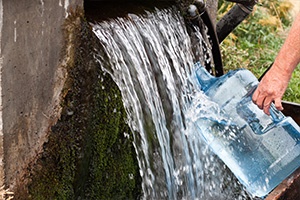 If you’re lucky enough to have a spring bubbling out of the rocks on your property, then you might already have a natural source of clean, delicious water.
If you’re lucky enough to have a spring bubbling out of the rocks on your property, then you might already have a natural source of clean, delicious water.
The hard part is building the infrastructure to harness it around the homestead, but with the help of gravity, it is possible.
Related: How to Build a Water Purification System in 10 Minutes
“Cascade” or Water Flow
This is more of a system of procedure than a mechanical one. But you will save and maximize water with it. There are generally 3 types of water: clean, gray, and black. You don’t need water that’s safe for human consumption to do laundry, wash dishes, or even water gardens and livestock. Using a proper water flow, you can “cascade” water from one level to the next.
If you boil water for food, that same water can be used to clean the dishes. The water you use to wash your hands can then be used to flush the toilet. Once you start becoming more aware of where your water comes from, and more proactive in attaining it, the more ideas will come to you of how to preserve and use it to its maximum potential.
The Last Off-Grid System
 A water filter will help out a lot.
A water filter will help out a lot.
You can buy a popular but expensive, heavy duty one from Berkey, or you can make one from materials on your land called a Biosand Filter.
Check out a website from a Canadian charitable organization called CAWST to download a free manual on building it, but the gist of it involves a barrel full of sand and gravel, and a top layer of micro-organisms which all eliminate harmful pathogens through a process of predation, trapping, absorption, and natural death.
There are many more systems possible, and some of these might not be possible for every homestead. Researching what other people have done on properties similar to yours is a good way to get some ideas. It is important not to have just one system, but as many as possible in case something happens. Water can run out or become contaminated, even poisoned. If SHTF, having a secure source of good water will be the first step to surviving and flourishing.
You may also like:
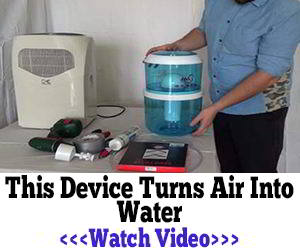 The SHTF Diet: Minimum Food And Water Supply For 3 Months
The SHTF Diet: Minimum Food And Water Supply For 3 Months
10 Things Cowboys Carried With Them in the Wild West to Survive (Video)

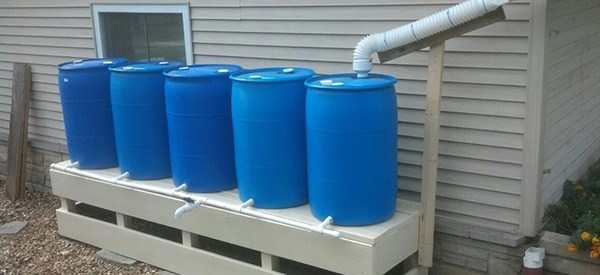













Even though we’re (still!) in a (stupid) smart city, I’m recycling so much water from the kitchen and bath that we’re sometimes collecting too much to carry/store. The plants love it. The toilet loves it. Being in S-CA (still!) I always was surprised that I am the only one I know of who is recycling water to this extent. I only know one guy who collects shower water for the toilet. One guy! And only the shower water. BTW showering here without a good filter is not the best idea – the tap water here is so toxic and the skin so absorbent… Anyway, the neighbors here flush, rinse, use, and flush again w/o even thinking. I was raised on greener pastures and still seem to be a rare exception regarding appreciation of water.
We’re also the only ones in several blocks to have rain barrels…
I’d actually prefer barrels without spigots. All barrels we bought have spigots and all of them keep leaking and require attention at least once a year which is frustrating considering the short rainy season here. So personally, I’d prefer a simple scoop out barrel instead a potentially leaking spigot.
Hi Heidi: You are not alone. I am in SoCal also. I also collect shower water while waiting for the hot water to use on the plants. I used to put in a temporary line to the washer discharge hose to water plants with the wash water but with advancing age and some health problems it got to be too much to hook up every time I washed the clothes. If I had been able to close the garage door and use the discharge line, I would have done it, but all the collapsible hoses I used wouldn’t stay open for the discharge water. I had to use rigid pipe in order for the system to work.
I haven’t had trouble with spigots on rain barrels leaking. I have had trouble with the rain barrels themselves splitting in the hot California sun and leaking. I’ve tried various methods of patching the barrels because they aren’t giving them away, but so far have not found a suitable solution to split rain barrels.
I now look for rain barrels with a spigot close enough to the bottom of the barrel to make tipping the barrel to get the last of the rain water out less of a balancing act. I have a couple that I bought before realizing the defect in the design where the spigot is about a third of the way up the barrel. Makes it easy to connect the hose, but that much water left in the barrel makes tipping the barrel a real challenge. Perhaps if I were 20 to 40 years younger, it wouldn’t be so much of a chore. For barrels that have the spigot in a low enough spot to retrieve most of the water, I put them on top of cider blocks so that I have room to connect the hose to the hose bib.
On the few times that we do get rain, I have wading pools that I bought at Wally World for less than $10 each that I put out. I use the cheapest pump that Harbor Freight sells to pump the water from the wading pools into a 5 gallon bucket to fill the rain barrels that don’t have a downspout to them. If you wait until the end of summer you can buy rigid wading pools at a good discount. I don’t remember if mine are six foot pools or eight foot pools I suspect they are six foot. When they are empty I can pick them up and place them wherever I want to catch rain. It is surprising the amount of dust the rain washes from the air in the first hour or so of a rain storm.
I have a couple of neighbors who are still trying to make concrete grow by watering it. Our city is using well water for supplying the city. We have trouble with salt water intrusion being as close to the coast as we are and the water is really bad. We have been paying $250,000 a year since sometime in the 1960s for the right to connect to water from the Owens Valley. Unfortunately the closest hookup point is about 75 miles away and there is no way the city is going to be able to afford a pipeline from that far away. Lots of folks shouting to drop the right and save a quarter mill a year and put it to better use but the city keeps saying they are still working on a plan. I think they would be better served to spend the quarter mill on lottery tickets.
LCC, would it be possible for you to get a hand pump and suck out the water left in the barrel? I have two manual pumps for my small boat that i use to pump out the bilge. One has a shorter hose and one that’s much longer. I can see that if you have a way to remove the top of the rain barrel so you can snake down the hose and start pumping, you can get out that last bit of water.
Could not find the brochure on the CAWST website. How about a link directly to it?
Wood- look up slow sand filters. Same thing
Awesome way to think outside the box and have water with pressure but you need to make it safe
Rainwater from gutters really isn’t very clean. Your gutters collect dirt, pollen, pigeon poop, leaves, and plenty of other things the rainwater washes over. It isn’t potable.
It is fine for gardening or toilets, but rainwater for drinking must be filtered and disinfected first.
That’s right … but, it’s worth it. This is how everybody in New Zealand gets their water … or Australia. They’ve all got 10-20,000 gal tanks hooked up to their roofs. Put an OZone system in your tank, use a green sand filter coming out of the tank. Then, use an activated carbon filter before drinking it. If you need to … put some chlorine tablets in the tank – use a swimming pool floater for the tablets … replace once per month.
I don’t know how old most of you are out there. I was born in 1951, but due to some quirky family traits, We lived many places that we had to carry every drop of water we used. Some places had a well, mostly hand drawn, a few electric pumped. Some places was a stock tank ( or pond) and had to get drinking water from a safer source. There were the rain barrels of course. One place had a spring with a small electric pump so the water lines were buried for winter. The one place that stands out in my memory was an old ranch house that had a cistern. It was of course hand dug. The house had gutters the fed the cistern, between the gutter down spout and the cistern was a sand/ rock/ gravel and screen filter. Even though many people would have, and did, directly from it, we always boiled it before drinking. If you can find plans for the old structures and see how it was done, or if you are lucky enough to have friends or relatives from earlier times.
The sloping part of our property was terraced in the swale and berm method described in the article over 100 years ago when this area was the center of the world cotton industry. I can say without exaggeration that not a drop of rain that falls on my land goes anywhere else, and it is erosion free. Preppers talk about a SHTF (I’m reading a novel by James Rawles who says ‘when the Schumer Hits The Fan’ which is pretty funny even for a cynical old liberal like me) leaving us to live an 18th century lifestyle but all the work in the old days was done by sharecroppers living a 16th century lifestyle, I take good care of those hand built berms.
The last owners of my home had the HVAC drain going into the rain gutter, which rotted the gutter, I ran the drain into 3/4 PCV into a 55 gallon barrel, that fills up in the summer in two-three weeks, and can water the lawn, trees and shrubs. It also can be used for drinking water, when property treated or boiled…..
If you are thinking of building a pond, go on line and look for koi pond suppliers. They have everything you need to build ponds from liners to filters and most importantly, knowledge.
If you are going to grow fish, you need to have your pond deep enough so that critters and birds can’t get your fish. Three feet is the minimum depth that you should make your pond. Deeper is better. Better to go small and deeper than bigger and shallower. If you live in alligator country, of course, you have to watch out for Allie Alligator who will clean your fish out in an instant and then will start looking for warm blooded prey.
PS: First hand knowledge about koi ponds and critters who feed on fish. Another case of too soon old, too late smart.
After Hurricane Harvey our subdivision flooded thanks to the blunderings of the Army Corps of Engineers. Several of my neighbors had koi ponds.
When water had receded enough to allow me to wade back to my house, I saw orange fish moving around. My first throught was, “Turn around and get out of the water,” but then I realized, “Koi!” My neighbor’s yards were underwater, and the fishies just swam out.
Most works if you get rain. We’re in a rain shadow and most storms miss us, but do hit the mountains. So, the water table is pretty high for Arizona. We’re hoping for a soaker this week. If so, those dry rain barrels will get something in them, again. niio
Something else to keep in mind for water sources is your water heater. There is a spout at the bottom for draining the water heater. If you use this water make certain to turn the breaker off. Otherwise when power is restored you will burn the elements up the the tank. Also, the water in the commode tanks is a good source of clean water.
Will this work Without Electricity
Siphon the water from the bottom of the tank. Read how.
Though ponds were mentioned and LCC mentioned putting out wading pools when it rains, I did not see a mention of either in-ground or above-ground swimming pools. (Or, I simply missed it. Not impossible.) While, if you have any other source of drinking water turning swimming pool water into potable water is usually not worth the time or hassles, though it can be done, of course.
A couple of ideas in the article and the comments are similar to this one: Have one or more ‘water features’ in both the front yard and back yard. Some of these can hold significant amounts of water, even if only a small area is exposed on top. The actual water hold area can be dug down quite a bit more than what the normal plastic form is or the pond liners are designed for. Like swimming pools, if the water is treated you would want to use it for things other than drinking. Though it would not need the same levels of treatment that swimming pools do since no one would be in the water.
Water features can be used in this way to hide or camouflage other types of outside water storage systems to make people believe that there are only a few gallons of water involved rather than possibly hundreds.
As one person said in the replies to the article, where legal, start collecting and storing every drop of water that lands on your property. (You often cannot collect water crossing your property, no matter what rain collection laws state.)
And even if you cannot do it right now, get everything ready so you can immediately start collecting those drops from precipitation just as soon as there are no longer any legal forces to prevent it or prosecute you for doing it.
If you have an unused area of yard, such as a side yard, that is relatively flat, or any area where you can safely dig and then cover a trench, you can put in a huge water reservoir by digging a trench or trenches on contour lines, lining them with plastic that can be brought up and overlap at the top of the trench. The plastic-lined trenches then can have covers over them that can support however much weight might be placed on them, and then covered with earth and planted with grass or perennial food crops.
A two-foot wide, two-foot deep, one-hundred-foot long trench can hold almost 3,000 gallons of water. And remember, water storage can be filled without waiting for precipitation by simply filling from your regular water supply, unless illegal or too expensive.
Just my opinion.